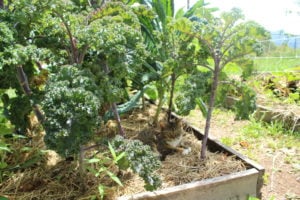Happy Friday Grow Appalachians. And October marches on and on…It’s hard to believe that in just a couple of months we’ll be ringing in 2017. I have to say that, for me, 2016 has been a purty fantastic year!
We emphasize season extension to all of our Grow Appalachia sites, but for those of you that are not pursuing season extension endeavors, I’m going to be sharing a few hints at how to put your garden to bed for the season. That is, until the next big thaw come spring time…which, at this rate, will again be here before we know it.
Clean It Up!
- Remove any diseased or dead plant matter, as well as dried foliage, corn stalks (if you grew any), squash vines, dried pea plants, anything that could potentially harbor harmful insects or trap disease. Anything that is not diseased can be added to your compost pile; otherwise burn or discard at a distance from your garden site.
- Once your garden has been cleared of any plant debris, now is a good time to do one last good weeding. Any weeds that are left behind could go to seed during the winter and create many, many new weeds.
- If you used black plastic mulches or any other mulch materials that don’t break down in a growing season, now is the time to pull those up. If they’re left down, this can cause potential breeding grounds for pests that go dormant in the winter.
- If you used any trellising systems, pull up any t-posts or stakes, as well as any string or twine. Twine can be reused if it’s still in good shape; if not, a good bail of it is relatively inexpensive.
- If you have fruit trees growing near your garden, remove any fallen fruit. Again, this will help reduce pest pressure.
Cover It Up!
- Mulch heavily this time of year! If you’re raking leaves, save them and add them as mulch for the garden. The added nitrogen in the leaves will break down during the winter, improving the nutrient content in the soil. Make sure the leaves are finely shredded before they’re applied so they don’t “mat” down. Add a layer of compost or manure on top (if you have it).
- If you are lacking in the organic matter department, considering sowing a cover crop. Cover crops help to boost soil nutrients and organic matter, as well as prevent soil erosion and reducing weed and pest pressure. You can read more about cover crops from this HQ blog post.
- If you are in fact planting fall/winter crops, of course you can always use row cover or low tunnels, but for a more budget-friendly alternative, try using old sheets. Yes, as in bed sheets. How’s that for recyling?
- Straw is also a good mulch for the winter. Be sure it’s straw and not hay! Hay can contain weeds and/or weed seedlings. More weeds= not good! Pine needles are also a good alternative.
Other Odds and Ends
- I read in several different sources that fall is a good time to get your soil tested. Any amendments you may need to apply after receiving the results of the test will assure that your soil is plant-ready come spring time. Plus, labs won’t be nearly as busy this time of year.
- Regardless of whether you decide to cover crop or mulch (or both!), remember that it is not ideal for soil to be kept bare and exposed.
- As you clear your garden and garden beds, take notes on your garden for the year. What grew well and where, and how much did you harvest? What varieties or crops didn’t grow well? Did you have any issues with a particular pest? Making notes of these things now will save you some time later in garden planning.
- Since it’s mid-October, it’s a little late in the season to plant crops in open soil…with the exception of garlic. Garlic can be planted after the first frost…which, here in Berea, no frost yet!
- If you’re looking to expand your garden and create new plots, mow the grass as low as your mower will go, lay several layers of newspaper or cardboard, and then add in compost or leaf mold on top of that!
- Don’t ignore your tools, or leave them to freeze! Give them a good cleaning and, if necessary, lightly oil them to prevent rust. Be sure they are stored properly as well.
- Watch the weather, not the calendar. We should all know by now that Mother Nature doesn’t exactly stick to a schedule…
How do you put your garden to bed for the winter? Share your quips, pics, tips, and tricks with us, and until next time, happy fall! Man, I am LOVING it.
Resources/Further Reading
Autumn garden clean-up from the Farmers Almanac
Garden Clean Up from Vermont Extension
Real-World Winter Gardening Tips from Mother Earth News (tons of valuable information)





Leave A Comment